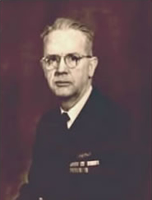Laurance F. Safford
| Laurance Frye Safford | |
|---|---|
 |
|
| Born |
October 22, 1893 Somerville, Massachusetts |
| Died | May 15, 1973 (aged 79) Bethesda, Maryland |
| Allegiance |
|
| Service/branch |
|
| Years of service | 1916–1953 |
| Rank |
|
| Commands held | Assistant Director of Naval Communications for Cryptographic Research |
| Battles/wars |
World War I World War II |
| Awards | Legion of Merit |
Captain, U.S.N. Laurance Frye Safford (October 22, 1893 – May 15, 1973) was a U.S. Navy cryptologist. He established the Naval cryptologic organization after World War I, and headed the effort more or less constantly until shortly after the Japanese attack on Pearl Harbor. His identification with the Naval effort was so close that he was the Friedman of the Navy.
Safford was born in 1893 in Somerville, Massachusetts. He secured an appointment to Annapolis, and graduated fifteenth in the class of 1916. In January 1924 he was called from command of a minesweeper off the China coast to head the "research desk" of the Code and Signal Section within the Office of Naval Communications. In the beginning his sole task was to exploit a Japanese naval codebook that had been filched from the Japanese consulate in New York City. To do this he had four civilian clerical employees.
Safford promoted the effort throughout the Navy, attracting Agnes Meyer Driscoll, Joseph Rochefort, Joseph Wenger, and others who were to lead the business through World War II and into the postwar period. He was the first to begin organizing the worldwide Naval collection and direction finding effort, so that when the United States entered World War II it already had a system of intercept stations. Safford himself was wrenched out of the job in 1926, returning in 1929. He remained with the effort except for another sea tour from 1932 to 1936. Meanwhile, the effort that he headed broke Japanese naval codes, and began mechanizing its operations with the addition of IBM equipment. Safford himself was directly involved with building cryptographic machines, and collaborated with the Army's Frank Rowlett in the invention of the Sigaba, a cipher machine not known to be broken by any country during World War II.
...
Wikipedia
